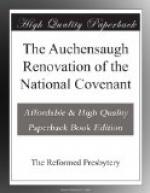Besides circumcision and the passover, both of which involved covenant obligation, God instituted the additional ordinance of public and social federal transaction, that the whole body might glorify him by a united act of solemn dedication as his special property separated visibly from the world. Is. lxiii: 19. And that this is a moral ordinance, and of perpetual obligation, is evident from the practice of God’s people, both under the Old and New Testament, and the language of prophecy. Deut. xxix: 10-12; 2 Cor. viii: 5; Is. xliv: 5.
Again, when we renew our covenant, we do not mean that the obligation has ceased, or that we can increase its obligation, for this is infinite and permanent; we intend by our personal act to deepen and render more durable our sense of preexisting obligation. This is, indeed, the immediate object of all renovations, by Moses, Joshua, kings of Judah and Nehemiah. And as we have seen, this ordinance was observed by Christians in the time of the apostles, so their practice may be traced through history afterwards, however obscure, until the time of the Reformation from Popery; when in Europe, both continental and insular, this ordinance was revived and exemplified. Among all nations in Christendom Scotland stands preeminent since first emancipated from bondage in mystical Babylon, for the frequency and fidelity of her ecclesiastical and national vows to the Most High. After many struggles with Popery and Prelacy, during which Christ’s witnesses in that land derived strength and courage from vows renewed to withstand these organized oppressors; at length by their example and influence the kingdoms of England and Ireland were brought into a confederation by that famous and grand document, the Solemn League and Covenant. Taken in connection with the National Covenant of Scotland, those three nations and the churches in them were voluntarily bound to God and to each other by all the solemnity of cords and bands made in heaven. Yet, through the corruption of human nature and the restless malice of the Dragon and his angels, these bands were treacherously broken and the cords cast away. Although those symbols of the public faith were Scriptural documents, yet the reformation as truly described by the late Mr. Robert Lusk, was to the majority “a reformation only on paper.” Like Israel of old the hearts of most of the people were not right with God, neither were they steadfast in his covenant. Ps. lxxviii: 37. This was soon made manifest by the Public Resolutions, accepting Indulgences, and the subsequent twenty-eight years of persecution inflicted upon those who “stood to the covenant.” Then followed, in 1689, what the apostates called, and their successors still fondly hail, as the “glorious Revolution settlement!”—a settlement which, by forms of law, consigned the nations’ solemn vows to oblivion, with all possible expressions of detestation by the infamous “Act Rescissory.” In the year 1707, the “Act of Incorporation” brought the church and kingdom of Scotland under degrading bondage to the anti-Christian, Prelatic and Erastian throne of Britain.




